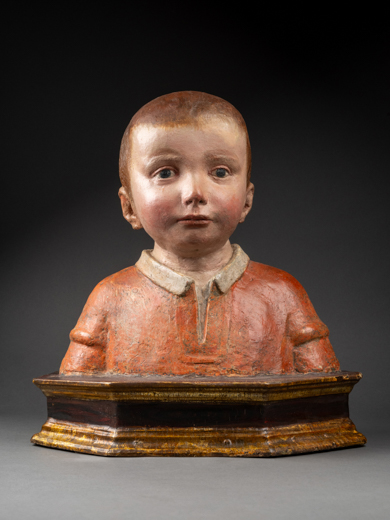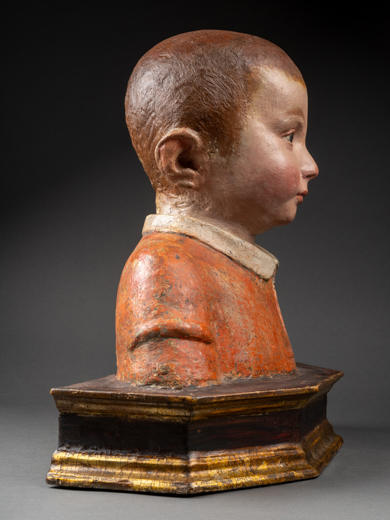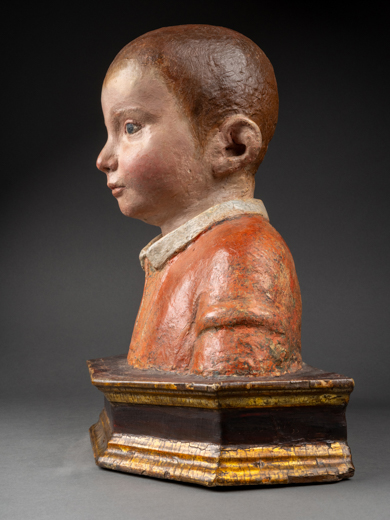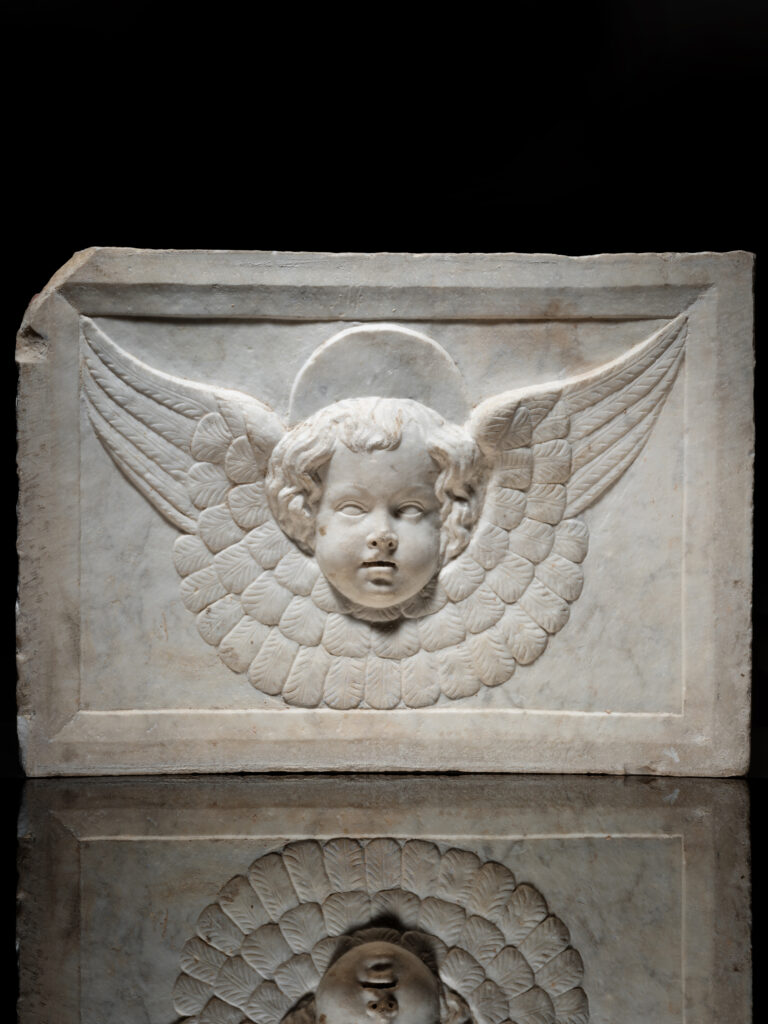Exhibitions :
A. Del Priori, in Rinascimento Segreto, a cura di Vittorio Sgarbi, 2015, pp. 170-171
The small sculpture represents the bust of a young boy dressed in a white shirt, with the collar visible, and a red jacket open in a V shape on the chest. Cut just under the shoulders, the sculpture represent a little boy of a very young age, probably around three years-old. The face is characterized by a slightly upturned nose, rosy and chubby cheeks, and a small mouth. The bust rests on a hexagonal contemporary base partially gilded.
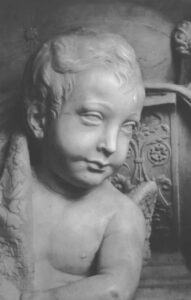
The plastic carving of the eyes, drawn as if with a scalpel, and the broader eyebrow arch, as if modeled with fingers, suggest an artist of exceptional technique. The stucco is skillfully carved as to evoke the smooth skin of the cheeks and the chubby flesh of the neck.
The pronounced Tuscan features of this bust, coupled with stylistic similarities to certain Renaissance busts of young boys by Desiderio da Settignano, have led to the attribution to Antonio Rossellino1. The sculpture was showcased in a Renaissance exhibition curated by Vittorio Sgarbi in 2015 and was later included in the exhibition catalogue.
Close comparisons can be made with some of Antonio Rossellino’s Children, such as the stunning one in the terracotta Madonna at the Victoria and Albert Museum (which also has a controversial attribution often shared with his brother Bernardo) or the one in the round with the Madonna of the monument to the Portuguese cardinal in San Miniato al Monte in Florence.
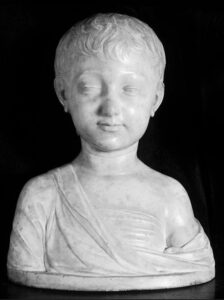
The bust of a young boy was a Renaissance sculptural genre, most likely invented by Desiderio, that originated in mid-quattrocento Florence and whose production ended around 1510, with the fall of the republic. Executed in marble, terra-cotta, or stucco, similar busts were produced in sizable numbers by artists such as the Rossellino brothers, Bernardo and his younger brother Antonio, as well as Desiderio da Settignano. The busts are never exact likenesses of any actual child. They were based on natural form and expression, yet all are idealized images. No child bears a physical flaw or displays a blemish. The presumed ages are intentionally vague, because what they represent are ideals rather than appearances. Such busts belong to a 15th-century context in which childhood was first recognized as a distinct stage of life. They had a new status as individuals during the Renaissance, and their moral development was of increased concern, not only to parents but also to the state, which needed them as good citizens. Contemporary sources indicate that the male child was particularly seen as symbols of familial and civic continuity. Influenced by civic humanism, the busts echoed earlier Roman ideals, where children were considered guarantors of both family lineage and the state’s future.
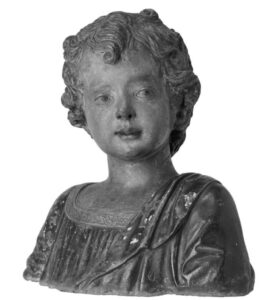
The use of stucco perfectly illustrates the “carefree and imaginative” work of sculpture workshops in Florence during the Renaissance. Stucco was the focus of particularly wide-ranging experimentation in the Quattrocento, and especially in the Florence of Donatello, where artists and architects deployed this versatile material to create figural and relief sculpture and novel decorations that blurred traditional distinctions among mural decoration, sculpture, and architectural ornament.
The representation of children in Renaissance sculpture transcended mere portraiture; it became a profound exploration of innocence, spirituality, and the beauty inherent in the fleeting moments of childhood. The busts were artistic expressions of a civic humanism based on democratic ideals of the future of the state and its citizens. Once the future was fated to be autocratic rather than democratic, these manifestations of republican civic promise ceased to have much relevance, and the genre came to an end.
This bust is, therefore, a rare and interesting example of a sculptural genre that reflects the specific political situation in Florence, vividly illustrating its civic ideals. The brief lifespan of such works makes this sculpture a rare testament to a particular historical, philosophical, political, and artistic moment that allowed the extraordinary flourishing of the Renaissance.
Bibliography:
Arnoldi, Francesco Negri. “Busto di Bambino.” In Donatello e i Suoi: Scultura fiorentina del primo Rinascimento, exh. cat. Alan Phipps Darr and Giorgio Bonsanti, eds. (Milan: Mondadori, 1986), p. 240, no. 97, ill.
Bellosi, Luciano. “Ricordi di Carlo De Carlo e della sua collezione.” In Un tesoro rivelato. Capolavori dalla Collezione Carlo De Carlo, exh. cat. Mario Scalini and Angelo Tartuferi, eds. (Florence: Giunti, 2001), pp. 20-21, fig. 5
Coonin, A.W. “Portrait Busts of Children in Quattrocento Florence.” Metropolitan Museum Journal, vol. 30, 1995.
Del Priori, A. “In Rinascimento Segreto,” edited by Vittorio Sgarbi, pp. 170-171.
Luchs, Alison. “The Bambini.” In Desiderio da Settignano: Sculptor of Renaissance Florence, exh. cat. Marc Bormand, Beatrice Paolozzi Strozzi and Nicholas Penny, eds. (Milan: 5 Continents, 2007), pp. 162-63, fig. 102
Mann, James G., Wallace Collection Catalogues. Sculpture, London: The Wallace Collection 1981, pp. 20-21
Planiscig, L. Bernardo und Antonio Rosellino. Schroll, 1942.
Radcliffe, A. “Portrait-Busts in Renaissance Florence: Patterns and Meanings.” Exhibition Catalogue, Florence, 2001.
Ross, J. “The Middle-Class Child in Urban Italy, Fourteenth to Early Sixteenth Century.” In The History of Childhood, edited by Lloyd de Mause. New York, 1974.
Trexler, R. The Children of Renaissance Florence. Binghamton, 1993.
Von Bode, W. “Portraits of the Sons of the Florentine Nobility of the Quattrocento in Busts of the Boy Christ and the Youthful St. John.” In Florentine Sculptors of the Renaissance, edited by J. Haynes. New York, 1928.
Warren, Jeremy, « The Wallace Collection- Catalogue of Italian Sculpture », London: The Trustee of the Wallace Collection, 2016, pp. 46-9, cat. No. 8
Antonio Rossellino was the most accomplished sculptor among five brothers, all trained in the important workshop led by the eldest brother Bernardo. Widespread admiration for Antonio’s skill may explain why his nickname Rossellino, “little redhead,” came to be attached to all his brothers, replacing the family name Gambarelli. ↩︎
